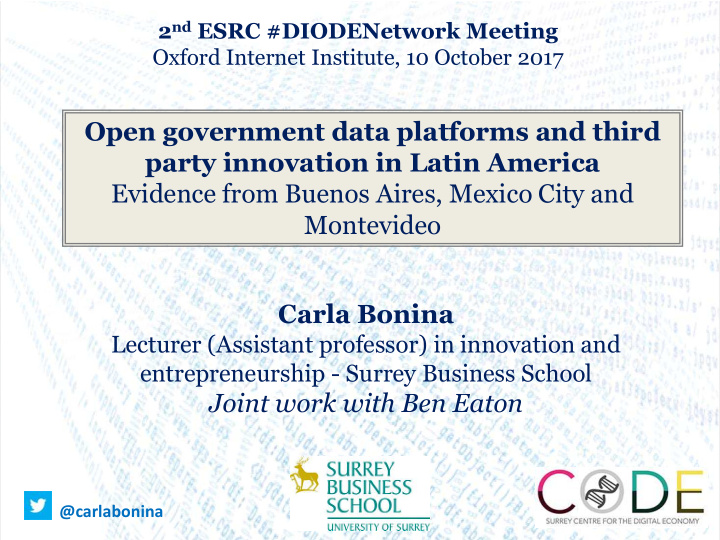



2 nd ESRC #DIODENetwork Meeting Oxford Internet Institute, 10 October 2017 Open government data platforms and third party innovation in Latin America Evidence from Buenos Aires, Mexico City and Montevideo Carla Bonina Lecturer (Assistant professor) in innovation and entrepreneurship - Surrey Business School Joint work with Ben Eaton @carlabonina
Image Credit: Auregann via wikicommons http://commons.wikimedia.org/wiki/User:Auregann
Motivation (I) Open Gov Data Platforms: growing importance in the global South/Latin America @ carlabonina
Motivation (I) Latin America leads the developing world OD as a vehicle for innovation Struggle to make the ecosystem grow and generate broader impacts @ carlabonina
Motivation (II) Platform innovation literature: in order to generate value, platforms need to nurture an ecosystem of third party developers Fundamental feature of platforms are network effects: platforms become more valuable as more users use them (i.e. Parker and Van Alstyne 2005) Theoretical concept of boundary resources from Information Systems research ( Ghazawneh & Henfridsson 2013; Eaton et al 2015) Open data as platforms understudied ( i.e. Danneels et al 2017 ) @ carlabonina
Platform Boundary Resources “The software tools and regulations that serve as the interface for the arm’s length relationship between the platform owner and the application developer” (Ghazawneh & Henfridsson 2013) Resourcing : The process by which the scope and diversity of a platform is enhanced Securing : The process by which the control of a platform and its related services is increased Theoretical foundation in boundary object theory (Star & Griesemer 1989) and innovation networks ( Chesbrough et al. 2006 ) Application to date in functional platforms (e.g. iOS) @ carlabonina
Platform Boundary Resources @ carlabonina
Platform Boundary Resources Example: SiriKit @ carlabonina
Research question How are boundary resources developed in order to cultivate an installed base of third party innovators for open government data platforms? @ carlabonina
Research context and design We study the development and evolution of boundary resources in three open government data platforms in Buenos Aires, Mexico City and Montevideo • Exploratory, cross case comparative study (2012-2014) Theoretical sampling/information selection • • Government teams or hybrid teams directly financed by the government @ carlabonina
Findings (in progress) Buenos Aires Mexico City Montevideo Contextual 3M (13,5M) 8,9M (20M) 1,3M (1,95M) factors inhabitants inhabitants; half inhabitants. population under 29 Team of digital Home to strong years. government programs in innovators, linked to Creation of technology education. international innovation Lab in First to hold an open networks of OD since 2012; joint-venture data platform (2010); early days. government and NGO solid policy with entrepreneurial Solid policy foundations and IT direction. foundation from the team in open data begging (Open Gov Weak policy and free software. Decree 2012). foundations in early A strong civic tech org days; two parallel Established network leading civic tech open data platforms. of civic tech movement entrepreneurs. Disperse network of civic entrepreneurs. @ carlabonina
Findings (in progress, example) Platform Owner Resourcing (“Tools”) Securing (“Rules”) Data artefacts Contractual Artefacts • From 40 to 166 datasets Platform • Terms of use and licensing • 8 formats conditions of datasets • Codebooks developed released with platform • Search tool Designs updates (2012 onwards) Resourcing Securing • Adoption of Creative Software artefacts Commons license for all • 3 APIs claimed (in reality, software content (2013) interfaces) Boundary • 22 active apps by 2015 Resources Legislation/Policy • Open Gov Decree (156/2012) Social Artefacts establishes OD platform • 4 BA Hackathons • Decree 478/2013: open data • BA Apps contest (2012 & 2013) Uses by default • IoT contest (2014/2015) • Open data plan released 2014 • Gov Camp Third Party Applications Third Party Innovators / Developers/Re-users @ carlabonina
Summary preliminary findings The three cases demonstrate governments choose very different paths to build their open data platforms We find a correlation between the cases that put more efforts into resourcing and securing (tools and rules/boundary resources) the platform with the maturity they have reached @ carlabonina
Expected contributions and policy implications Empirical : A type of digital platform innovation that has not been investigated before Theoretical : Dynamics of boundary resource development in the context of a public good rather than profit motivation Policy : offer insights into the development of policy to facilitate the cultivation of an installed base of innovators, developers and re-users, and hence grow the value of OD platforms @ carlabonina
Thank you! Carla Bonina c.bonina@surrey.ac.uk @ carlabonina
Appendix. Research design Data Multiple sources of evidence • 24 interviews with open data leaders • Participant observation government teams in Buenos Aires and Mexico City and specialised conferences Extensive review of documents, blogs, social media outlets and • previous studies (Scrolini 2014; Fumega 2014; Belbis 2014) • Available data from the open data platforms Analysis Within and cross case (Eisenhardt and Graebner 2007) We examine the process of boundary resource development and evolution across the cases, develop a view of overarching patterns across the cases, and compare them with existing literature @ carlabonina
Recommend
More recommend